Burn up
When burning out is called in astronomy and space travel
- the evaporation of small particles ( falling stars or fireballs ) that enter the earth's atmosphere and suddenly heat up due to their high speed (approx. 20–80 km / s). Since they come from interplanetary orbits (mostly from former comets ), they come in with a multiple of the second cosmic speed . Before they evaporate, they ionize the air molecules, which causes the appearance of light ( recombination glow ) and sometimes a prolonged afterglow .
- a destructive re-entry of artificial missiles ( rocket stages , low-circling satellites, etc.) into the high atmosphere . Below about 200 km orbit height , the flow resistance becomes so great that the missiles disintegrate and their individual parts melt or evaporate. Only larger parts can - analogous to larger meteorites - fall to the earth's surface.
The picture on the right shows the calculated frictional force of a tiny meteor with a mass of 4 g in the atmosphere . This exceeds the weight by a factor of 500 and causes the meteor to warm up very strongly. The resulting thermal energy can be estimated from the mean friction force 10 N over a distance of 30 km :
- W = E th = F s = 10 N 30000 m = 300 kNm
If one assumes that half of it goes over to the meteor and the rest to the air, this also results
- E th = m * c * T
a temperature increase of about 80,000 ° C - the meteor completely evaporates.

The size from which astronomical bodies ( meteoroids ) reach the earth's surface as a whole must be more than about 80 meters when they enter the atmosphere, which corresponds roughly to the assumed diameter of the Tunguska meteor (Siberia 1908). However, this broke into several parts and caused extensive destruction of the forest by its pressure wave.
In astronautics , significantly lower speeds from around 3 km / s can become critical if the material reaches its thermal or strength limit. During the first rocket launches , it was found that the air density of the high atmosphere is about seven times greater than had been assumed by previous tests with high-altitude rockets . Unexpected heating up to 1000 ° C could therefore occur at about 200 km altitude.
In the case of interplanetary space probes that immerse into the atmosphere of a celestial body (descent or landing ), the energy dissipation - i.e. the reduction in speed - can take place through the frictional heat of the air resistance , whereby a controlled heating of over 2000 ° C is technically possible (e.g. planned atmosphere retardation or atmosphere capture on a moon or planet with atmosphere ).
See also
See also alternatively
- Heat shield
- Thermal conductivity
- Thermal diffusivity
- Specific heat capacity
- Heat capacity
- STS-107 #The disaster
Individual evidence
- ^ Space Shuttle Columbia disaster in the English language Wikipedia
